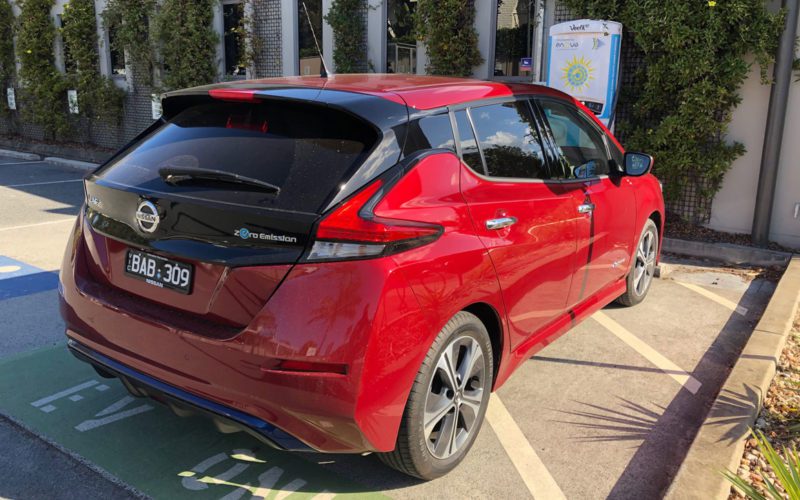You can certainly say this about the new Nissan Leaf electric car: There is no other mobile power source that even comes close to matching its acceleration, comfort and cornering.
That’s largely because there probably is no other power source that can actually be driven, unless you are thinking of Ausnet’s mobile grid-scale battery. And you’re not likely to use that to pick up the kids from school or duck down to the shops for a bottle of milk.
But if you are going to use the new Leaf, then you are going to be pretty happy. What’s more, if all does go to plan, you can then use the Leaf’s 40kWh battery to plug in and power the house if the solar is already exhausted, or you may wish to provide energy or services to the grid if such a market evolves.
But let’s take a step back first.
The new Nissan Leaf has finally arrived on Australian shores, just some two years after it was released elsewhere in the world.
That puts some perspective on where Australia sits in the global EV market – Hyundai, Tesla and others are and will treat Australian consumers the same. The rest of the world first, Australia second. You can thank our government, and its absurd views on EVs, and our lack of infrastructure, for that.
But the new Leaf is here now, and like the Hyundai Ioniq, it is pitched fractionally under the key $50,000 mark (although more once you add on-road costs), and so represents an important milestone in the falling cost curve of EVs.
The new Leaf differs from the first generation in several ways. It is bigger, a more sophisticated design, has twice the range (up to around 240km) thanks to its 40kWh battery (That could be more if Nissan ever decides to sell a bigger battery version in Australia), and it has vehicle-to-grid and vehicle-to-home capability.
The Driven’s chief reporter Bridie Schmidt, who had a loan of the Leaf for the best part of the week, shared her take on the new Nissan in this piece, and along with first generation Leaf owner and solar expert Muriel Watt, shares her experience in this edition of The Driven podcast.
But here’s my take, from the 24 hours I was able to sneak in between travel and family visits.

One, it is fun to drive. It has that electric vehicle feel – good acceleration, great handling (thanks to the batteries that lower its centre of gravity), and no engine noise.
Sure, it’s no Tesla or Hyundai Kona in terms of acceleration, but not all drivers think it is essential to get between every corner in the shortest possible time. Some drivers just like to relax and take it easy. If that’s your thing, the new Leaf could be your EV.
Two, it has an “e-pedal”, and it is really great. To explain, the Leaf has an accelerator pedal and a brake pedal, like any other car. But it also has a setting for “regeneration”, which allows the energy from a slowing motor to be put back into the battery, and it has some considerable grip.
I like this. It gives a lot of control to the driver. It means that for most slowing down, or even stopping, you can ease your foot off the accelerator and not even touch the brake pedal.
In 24 hours, I touched the brake pedal only twice. I think it is one of the great things about EV driving. Nissan is so proud it gave this sort of driving a new name, e-pedal.
Three: It is so easy to charge. I wanted a coffee so I stopped at the local library, plugged it in and saw it add 9kwh, or nearly 25 per cent charge, to the battery while I walked over and ordered my latte and waited for it.
Another time, we decided to go for a walk along the beach, so we plugged it in at another charging station and it did the same. Later, I plugged it in at home, and it “trickle” charged while the sun was shining on my solar panels.
All really cool. The layout and the look of the vehicle is really about individual choice and preferences. Sadly, the thing that could really decide whether this new Leaf is good value-for-money is not yet operating.
Nissan is still conducting trials and tests for its V2H and V2G technology. The network owners and market operators want a good understanding of how the inverters work, and the impact on the grid (and most likely the network owner and retailer business models).
To me, this is the most exciting part of the offering. No other EV maker yet offers such a thing, either because they are worried about battery warranty, or they want to sell separate household batteries to the home owner.
But let’s say it is allowed and it does work. A 40kWh battery would probably make any household battery redundant, and would offer some form of back-up in the event of an outage, or the opportunity to make money.
So much will depend on what the car is used for, and where it is garaged or parked, and what sort of tariffs and offerings that might be offered. We’ll just have to wait a while to find out. So stay tuned.

Giles Parkinson is founder and editor of The Driven, and also edits and founded the Renew Economy and One Step Off The Grid web sites. He has been a journalist for nearly 40 years, is a former business and deputy editor of the Australian Financial Review, and owns a Tesla Model 3.


